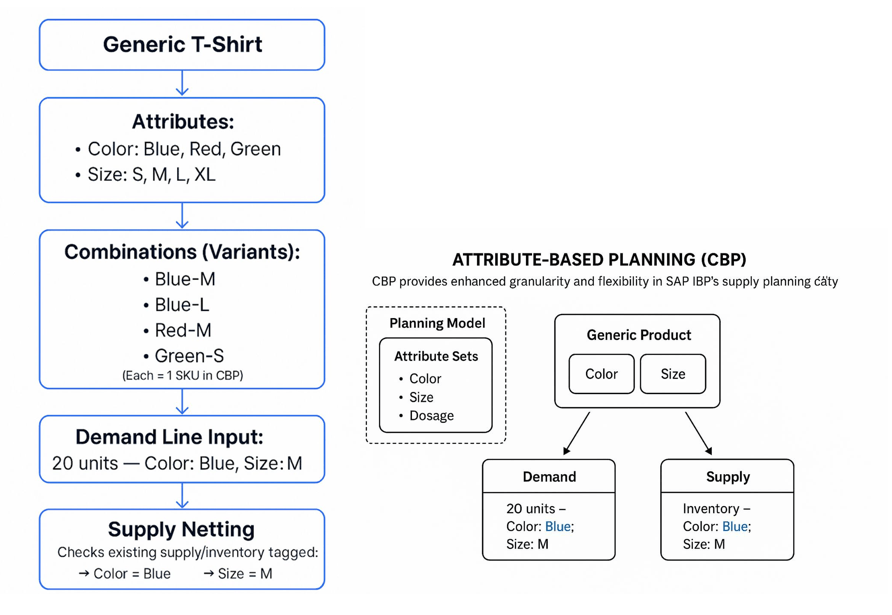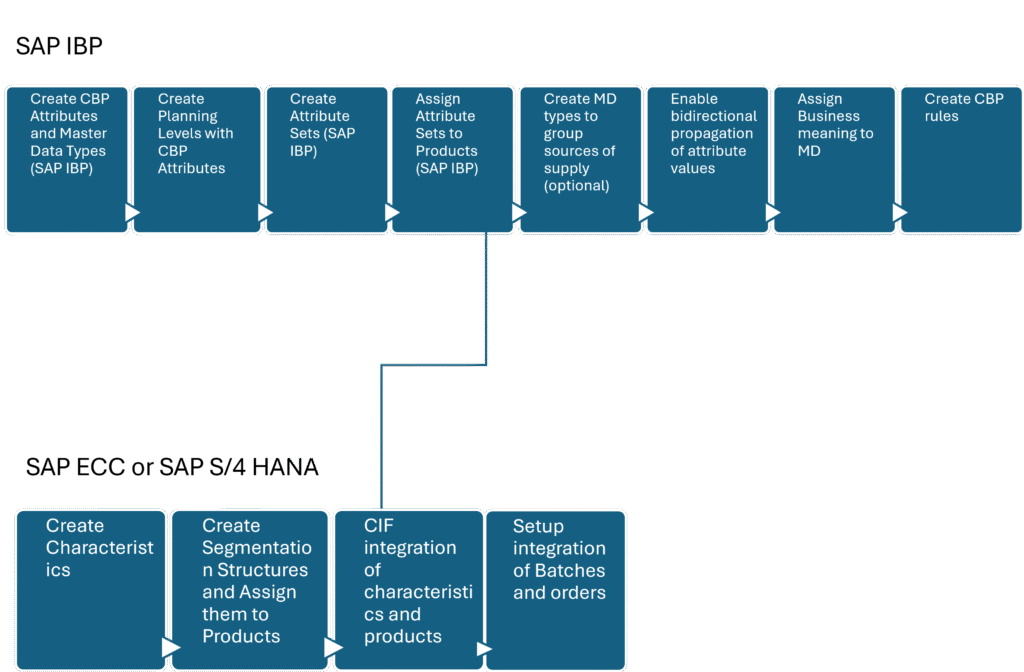Authored By: Stellium’s Supply Chain Planning & Business Consulting Team, Verified by Anirban Majumdar and Divesh Bali

Why Use Characteristic-Based Planning (CBP) in SAP IBP?
Characteristic-Based Planning (CBP) in SAP Integrated Business Planning (IBP) is a flexible planning approach that allows planning at any level of detail defined by user-specific characteristics. Unlike traditional planning based solely on product-location combinations, CBP enables planning based on additional attributes such as customer segment, region, product family, channel, and more.
Characteristics-Based Planning (CBP) enables efficient planning by modeling characteristics as CBP attributes, reducing the need to extend your master data model with product variants. It ensures that demands requiring specific characteristics are only fulfilled with supply elements that meet these requirements.
In practice, this means SAP IBP can support very granular planning: one supply plan can satisfy any demand that matches the specified attributes. For instance, demand for “red, size M t-shirts” can be met by any supply of t-shirts tagged with those attribute values. This attribute-driven matching allows customized product offerings and proactive supply-chain steering, enabling you to make customized product offerings and proactively steer your supply chain at a more granular level.
Why Use Characteristic-Based Planning in SAP IBP?
CBP provides enhanced granularity, flexibility, and responsiveness in planning processes and adds a new dimension to SAP IBP’s supply planning capability. Planners first define CBP attributes in the planning model (fields such as color, size, dosage, etc.) and group them into attribute sets for relevant products or product categories. In effect, CBP lets you think of a product not just as a single SKU, but as a combination of attributes.
For example, a clothing retailer might define one “Generic T-Shirt” product with attributes color and size. A demand line could then specify “20 units – Color: Blue; Size: M” and the planning engine will net that against any supply entries (such as existing inventory or planned production) marked as color=Blue and size=M.
Attribute-Based Planning Logic in SAP IBP – Matching Demand to Supply Using Variants

This means product variants are treated as flexible constraints, not rigid items. The result?
- Simpler master data management
- Better demand-supply matching
- Improved fill rates and planning accuracy
CBP transforms how you think about productsmaking planning smarter and more responsive in industries like fashion, pharma, and FMCG.
This avoids maintaining separate product codes for each color/size variant. These attributes provide greater detail and increased data analysis by adding the related attribute fields to master data. With CBP, SAP IBP effectively treats product variants as flexible constraints rather than fixed items. The supply that shares the required attribute values becomes eligible to fulfill the demand, improving fill rates and planning accuracy.
Here’s What CBP in SAP IBP Can Do for Your Business:
CBP delivers clear business benefits for companies with complex, configurable products. Key advantages include the following.
- Attribute-Driven Agility: Planners can respond faster to customer preferences and market trends. For example, by using attributes, a company can offer tailored configurations (e.g. customizing a product’s color or features) without rebuilding the entire product master. CBP enables customized product offerings and more granular planning, providing the strategic agility needed in markets where customers demand variety and personalization.
- Improved Demand-Supply Alignment: CBP ensures that any available supply matching the demand’s attributes is used first. In SAP IBP for supply planning, a demand can specify required attributes, and CBP rules will pull in any supply elements meeting those specs. This tightens alignment: planners can better match production or inventory to the actual mix of attribute-driven demand.
- Reduced Master Data Complexity: By grouping variants under a common product with attributes, CBP minimizes SKU proliferation. Companies no longer need to create a new item for every possible combination of features. This simplifies data maintenance and models. Planners can manage one “base” product and let CBP attributes handle the rest.
- Custom Aggregation Levels: Plan data at any combination of characteristics beyond standard master data.
- Improved Collaboration: Different stakeholders (sales, marketing, supply chain) can plan using dimensions relevant to them.
- Scenario Planning: Analyze different planning scenarios based on market/channel-specific assumptions.
How Characteristic-Based Planning Works in SAP IBP
CBP operates using the following components and steps:
End-to-End Flow for Characteristic-Based Planning Setup in SAP IBP and SAP ECC/S/4HANA

Industry Use Cases: CBP in Consumer Goods & Retail (Apparel, FMCG)
CBP’s flexibility makes it valuable across many sectors.
Clothing and consumer products often come in many colors, sizes, and packs. A retailer can define a base product (e.g., a “T-Shirt Style 123”) and attach color and size as CBP attributes. Now SAP IBP can plan and allocate “30 units – Size M, Color Blue” separately from “20 units – Size L, Color Red,” even though they’re the same style.
This streamlines planning for fast-fashioned or consumer products, where styles frequently change. Similarly, a packaged goods company with one recipe but multiple pack sizes can use CBP to plan by pack-size attribute instead of dozens of distinct SKUs. By focusing on attributes, businesses in these industries can adjust more quickly to trends and sales shifts without reworking product masters.
Conclusion
Improve Planning Agility with SAP IBP’s CBP Features
CBP in SAP IBP enables organizations to plan more accurately and efficiently by aligning planning processes with business characteristics and segmentation. With its flexible architecture and integration capabilities, CBP is a powerful tool for companies seeking to enhance their planning maturity in a dynamic business environment.
The inclusion of realistic scenarios further illustrates how CBP can be tailored to diverse industry needs, enhancing supply chain agility and strategic alignment.
Characteristic-Based Planning in SAP IBP helps organizations align supply chain planning with real-world business characteristics, enabling smarter segmentation, faster response, and better data-driven decisions.
Explore Stellium’s end-to-end SAP IBP solutions. Need expert support to implement CBP in your SAP IBP journey? Talk to us!
